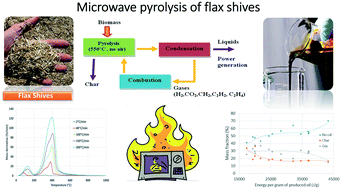Microwave pyrolysis is relatively new and has become an interesting option for the treatment of biomass residue due to its energy efficiency and high-quality products. The objective of this work was to investigate the microwave pyrolysis of flax shives and the influence of the operating conditions on product yield and quality. Three phases of pyrolysis, i.e., dehydration, primary devolatilization and passive lignin/residue degradation, were identified during microwave irradiation. Bio-oil production was clearly found to depend on two main parameters, which are the energy absorbed and the internal heating rate of the system. The optimal condition for the production of bio-oil was found to be around 13 000 J g−1 of treated flax shives, with a tendency to increase with the energy absorbed before going through a maximum, followed by a slight decrease, resulting in the production of gas. High heating rates of at least 120 °C min−1 and up to 200 °C min−1 provided the best bio-oil yields, which can only be achieved via microwave technology by internal heating. The bio-oil and gas quality in terms of chemical families was also discussed. It was found that the principal chemical families in bio-oil are carboxylic acids, ketones and phenols, where carboxylic acids are the dominant group. The four main compounds present in the produced gas are H2, CO, CH4 and CO2, where CO and H2 are the most abundant with concentrations of 43% and 31%, respectively. This work is a preliminary and essential step for an industrial transposition, the key features of which are finally examined.
